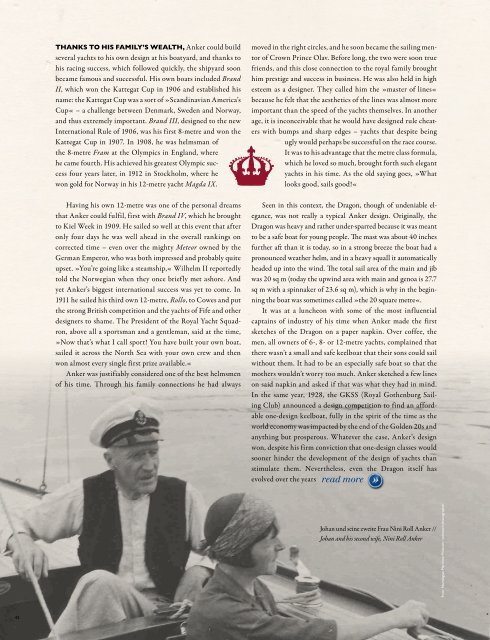Als PDF herunterladen - Robbe & Berking
Als PDF herunterladen - Robbe & Berking
Als PDF herunterladen - Robbe & Berking
You also want an ePaper? Increase the reach of your titles
YUMPU automatically turns print PDFs into web optimized ePapers that Google loves.
42<br />
THANKS TO HIS FAmILY’S wEALTH, Anker could build<br />
several yachts to his own design at his boatyard, and thanks to<br />
his racing success, which followed quickly, the shipyard soon<br />
became famous and successful. His own boats included Brand<br />
II, which won the Kattegat Cup in 1906 and established his<br />
name: the Kattegat Cup was a sort of »Scandinavian America’s<br />
Cup« – a challenge between Denmark, Sweden and Norway,<br />
and thus extremely important. Brand III, designed to the new<br />
International Rule of 1906, was his first 8-metre and won the<br />
Kattegat Cup in 1907. In 1908, he was helmsman of<br />
the 8-metre Fram at the Olympics in England, where<br />
he came fourth. His achieved his greatest Olympic success<br />
four years later, in 1912 in Stockholm, where he<br />
won gold for Norway in his 12-metre yacht Magda IX.<br />
Having his own 12-metre was one of the personal dreams<br />
that Anker could fulfil, first with Brand IV, which he brought<br />
to Kiel Week in 1909. He sailed so well at this event that after<br />
only four days he was well ahead in the overall rankings on<br />
corrected time – even over the mighty Meteor owned by the<br />
German Emperor, who was both impressed and probably quite<br />
upset. »You’re going like a steamship,« Wilhelm II reportedly<br />
told the Norwegian when they once briefly met ashore. And<br />
yet Anker’s biggest international success was yet to come. In<br />
1911 he sailed his third own 12-metre, Rollo, to Cowes and put<br />
the strong British competition and the yachts of Fife and other<br />
designers to shame. The President of the Royal Yacht Squadron,<br />
above all a sportsman and a gentleman, said at the time,<br />
»Now that’s what I call sport! You have built your own boat,<br />
sailed it across the North Sea with your own crew and then<br />
won almost every single first prize available.«<br />
Anker was justifiably considered one of the best helmsmen<br />
of his time. Through his family connections he had always<br />
moved in the right circles, and he soon became the sailing mentor<br />
of Crown Prince Olav. Before long, the two were soon true<br />
friends, and this close connection to the royal family brought<br />
him prestige and success in business. He was also held in high<br />
esteem as a designer. They called him the »master of lines«<br />
because he felt that the aesthetics of the lines was almost more<br />
important than the speed of the yachts themselves. In another<br />
age, it is inconceivable that he would have designed rule cheaters<br />
with bumps and sharp edges – yachts that despite being<br />
ugly would perhaps be successful on the race course.<br />
It was to his advantage that the metre class formula,<br />
which he loved so much, brought forth such elegant<br />
yachts in his time. As the old saying goes, »What<br />
looks good, sails good!«<br />
Seen in this context, the Dragon, though of undeniable elegance,<br />
was not really a typical Anker design. Originally, the<br />
Dragon was heavy and rather under-sparred because it was meant<br />
to be a safe boat for young people. The mast was about 40 inches<br />
further aft than it is today, so in a strong breeze the boat had a<br />
pronounced weather helm, and in a heavy squall it automatically<br />
headed up into the wind. The total sail area of the main and jib<br />
was 20 sq m (today the upwind area with main and genoa is 27.7<br />
sq m with a spinnaker of 23.6 sq m), which is why in the beginning<br />
the boat was sometimes called »the 20 square metre«.<br />
It was at a luncheon with some of the most influential<br />
captains of industry of his time when Anker made the first<br />
sketches of the Dragon on a paper napkin. Over coffee, the<br />
men, all owners of 6-, 8- or 12-metre yachts, complained that<br />
there wasn’t a small and safe keelboat that their sons could sail<br />
without them. It had to be an especially safe boat so that the<br />
mothers wouldn’t worry too much. Anker sketched a few lines<br />
on said napkin and asked if that was what they had in mind.<br />
In the same year, 1928, the GKSS (Royal Gothenburg Sailing<br />
Club) announced a design competition to find an affordable<br />
one-design keelboat, fully in the spirit of the time as the<br />
world economy was impacted by the end of the Golden 20s and<br />
anything but prosperous. Whatever the case, Anker’s design<br />
won, despite his firm conviction that one-design classes would<br />
sooner hinder the development of the design of yachts than<br />
stimulate them. Nevertheless, even the Dragon itself has<br />
evolved over the years read more<br />
Johan und seine zweite Frau Nini Roll Anker //<br />
Johan and his second wife, Nini Roll Anker<br />
Foto: Norwegian maritime museum / unknown photographer


